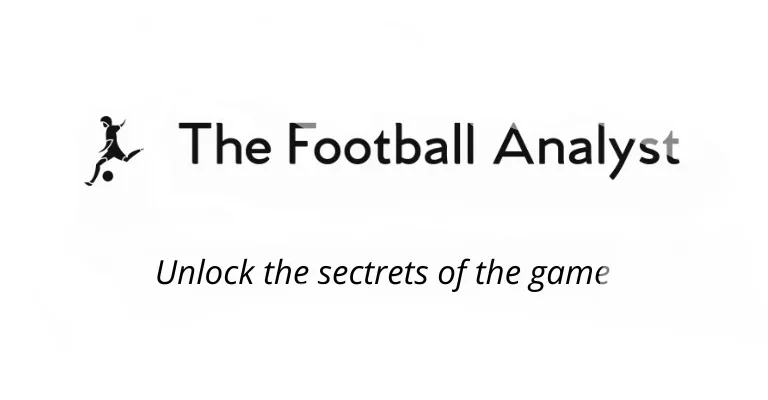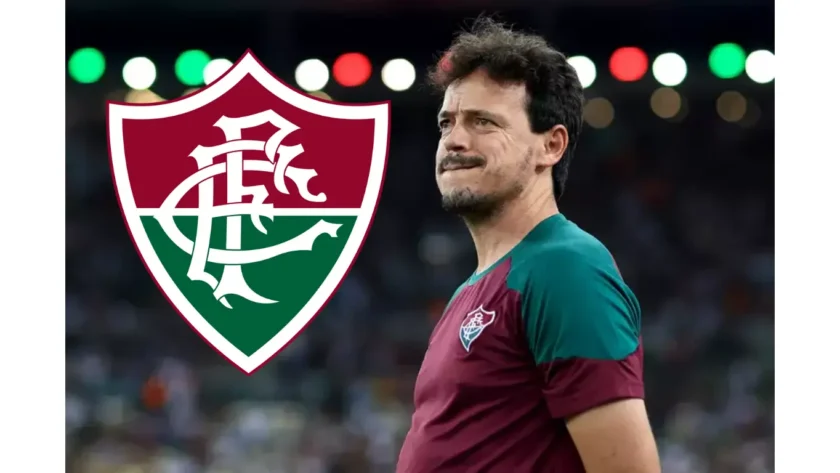Welcome to a comprehensive tactical breakdown of the footballing philosophy under Fernando Diniz at Fluminense. This analysis will delve deep into the strategic intricacies and stylistic nuances that define Fluminense’s approach under Diniz’s stewardship. Known for his emphasis on possession-based football and fluid attacking movements, Diniz has left an indelible mark on the team’s playing style. Join us as we dissect the formations, player roles, and key principles that shape Fluminense’s tactical identity under the guidance of Fernando Diniz.
Build-up
Fernando Diniz’s Fluminense exemplifies a unique brand of football characterized by relationism and high fluid build-up. At the heart of Diniz’s philosophy is the concept of relationism, emphasizing the interconnectedness and synchronization of players across the pitch. This approach prioritizes building cohesive relationships between players, facilitating intricate passing sequences and fluid movement off the ball. In the build-up phase, Fluminense display a commitment to maintaining possession through intricate passing triangles and dynamic positional rotations. By encouraging players to constantly adjust their positions to create passing lanes and numerical superiority, Diniz fosters a style of play that enables Fluminense to control the game’s tempo and dictate play from the back. Fluminense usually sets up in a 1-4-2-3-1 formation but constantly rotates into new shapes during the game.
Numerical Advantages
The most notable aspect of Fluminense’s unique build-up is their ability to create numerical advantages against the opposition in different areas of the pitch. Their fluidity and constant rotations are structured in a way where the players look to exploit the spaces where the opposition is weak.


Their main target is usually the opposition fullback, focusing many players around him to create an advantage there.


Fluminense are also good at exploiting these numerical advantages. They get the ball to one of the players, who waits for an opposition defender to push up. When the defender pushes up, the space behind him opens up, enabling the other Fluminense players to run into the open space and receive the ball.
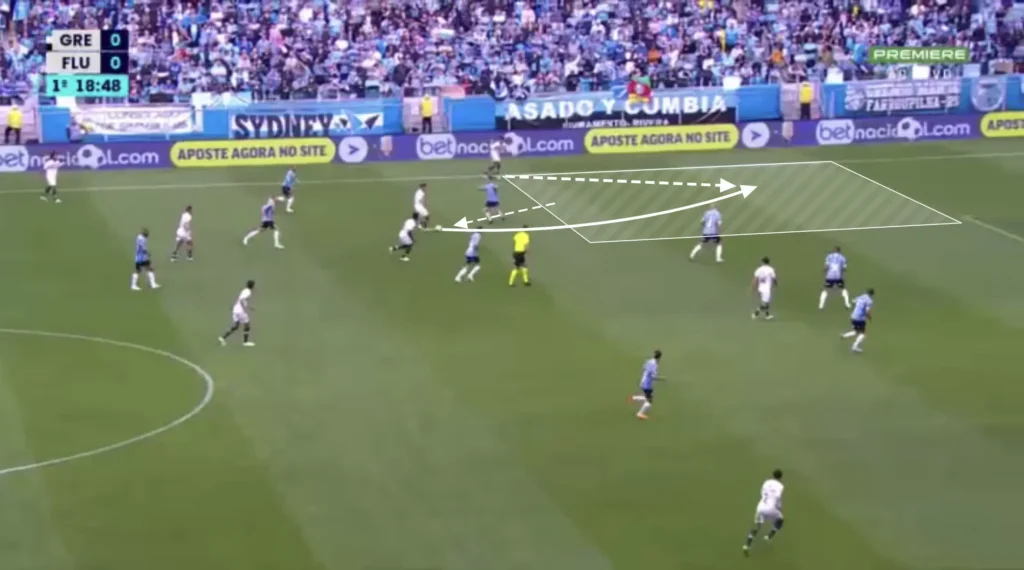
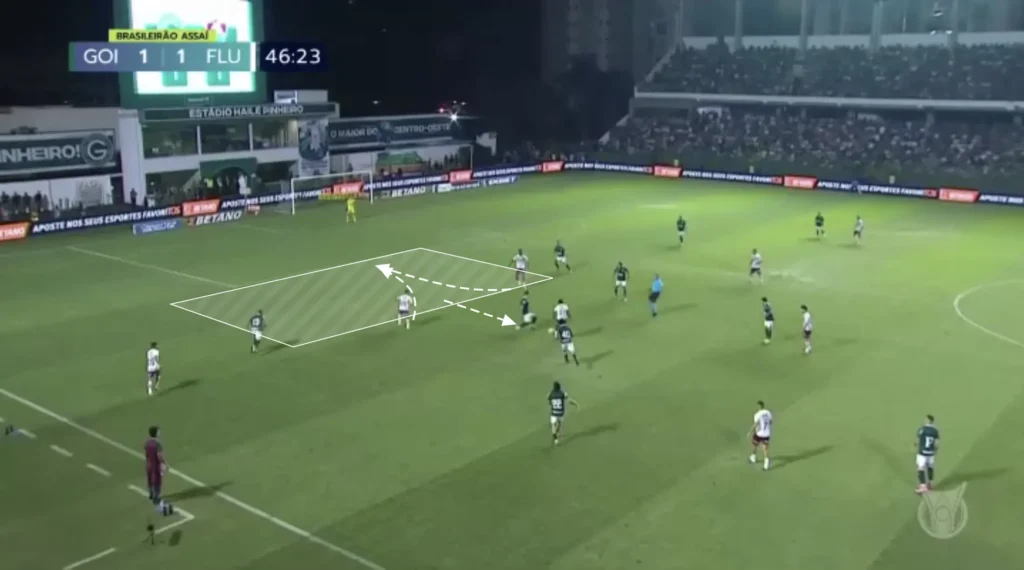
Low Build-up
In the low build-up, Fernando Diniz wants many players to come extremely deep and create numerical superiorities, which usually allows them to beat the press.
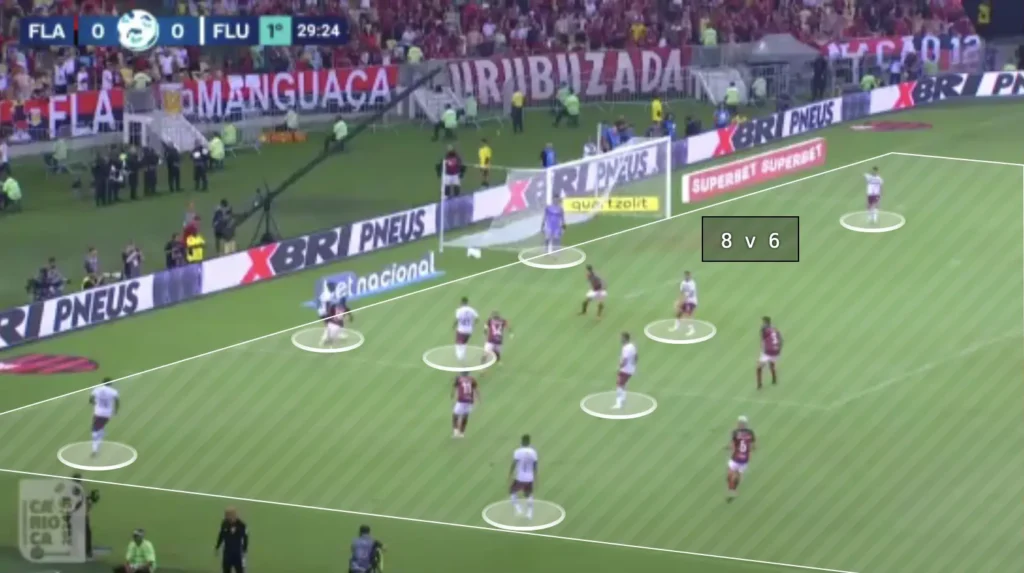
If the opposition answers this by pushing up many players and going man-to-man, Fluminense will go long and have a 3v3 or 2v2 upfront.
Goal-kicks
From the goal-kicks, a holding midfielder often comes into the penalty area and picks the ball up from the goalkeeper.

This forces an opposition midfielder to push up and press, which opens the space in the midfield, allowing a Fluminense midfielder to drop into this space and receive the ball. If an opposition player pushes up on the dropping Fluminense midfielder, more space will open up higher on the pitch for the Fluminense forwards to exploit.

High Build-up
In the high build-up, Diniz’s Fluminense tilts over to one side, pushing every player (apart from the weak-side fullback sometimes) over to the ball-side.
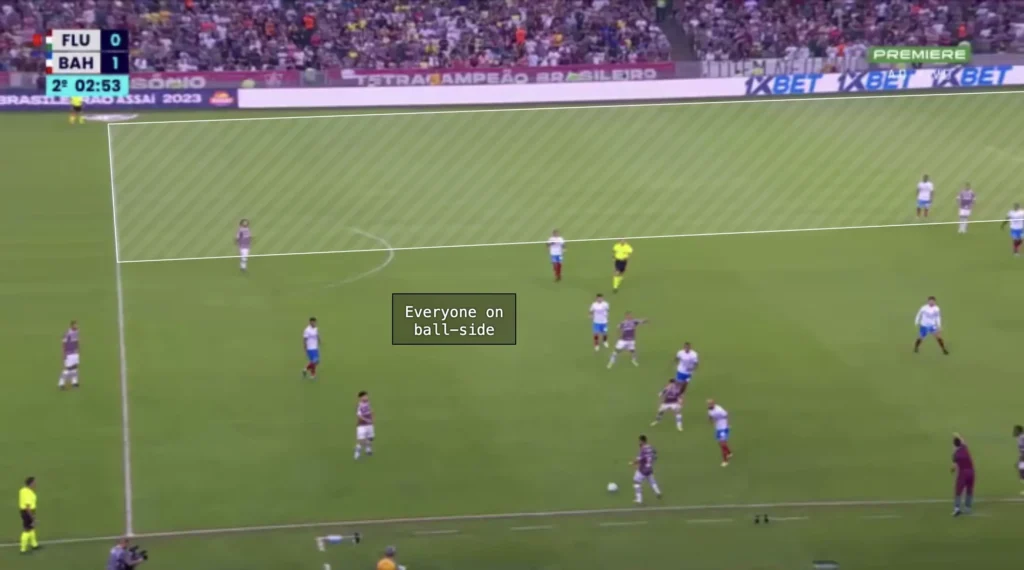
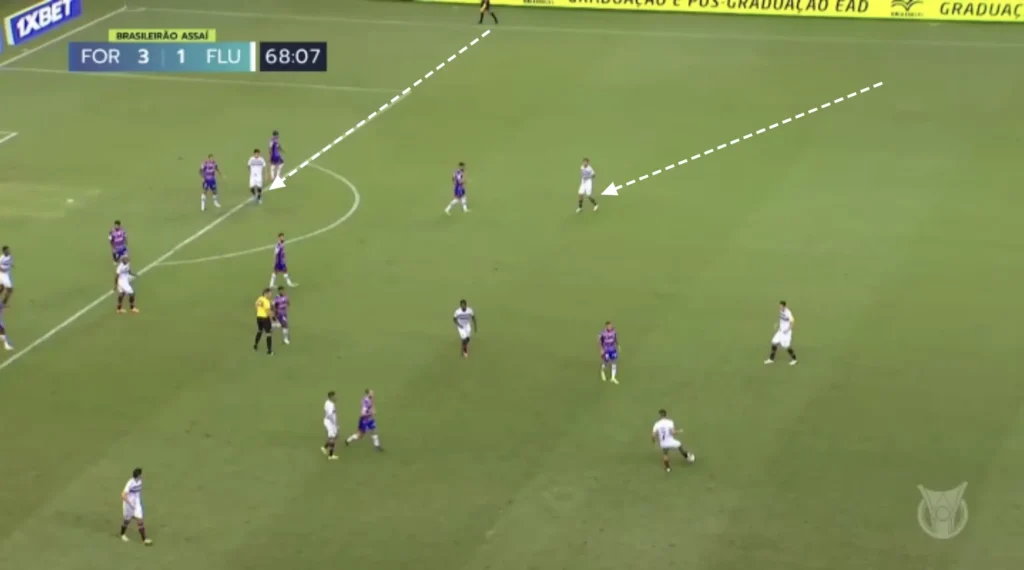
Having the players close to each other creates more options for the ball-holder and less space between the players. Fernando Diniz likes this because it builds good conditions in defensive transitions while making it easier to play through the opposition. Another purpose for keeping many players close together is to shorten the distances between them. This shortens the length of the passes, which naturally shortens the time between passes. This means the opposition players will have less time to push up and press, giving the Fluminense players more time and control.
Because they tilt over to one side, they rarely switch sides, often focusing the play on the side that they are on. Many teams know this and, therefore, leave the weak-side completely open. Due to this, the weak-side fullback sometimes pushes up into this space, allowing Fluminense to use the switch of play to create a 1v1 situation.

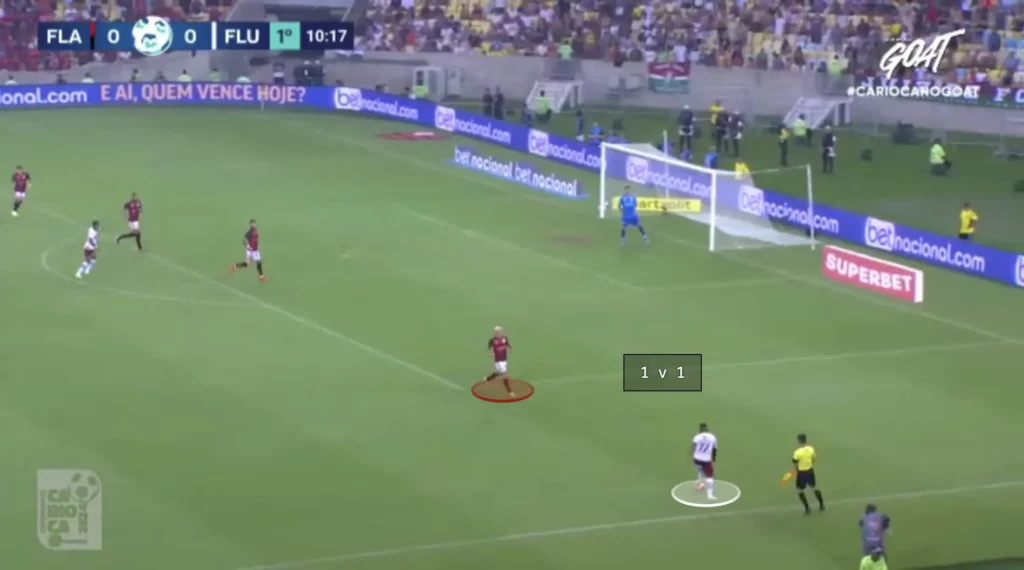
High Backline
A massive aspect of Fluminense’s high build-up is they keep a high backline. This helps in the counter-press because they get closer to the center. Having more players close to the center who can win the ball back makes it difficult for the opposition to recycle possession. Furthermore, the high backline shortens the distance between players, shortening the time and length of the passes and preventing the opposition from pushing up their defense.

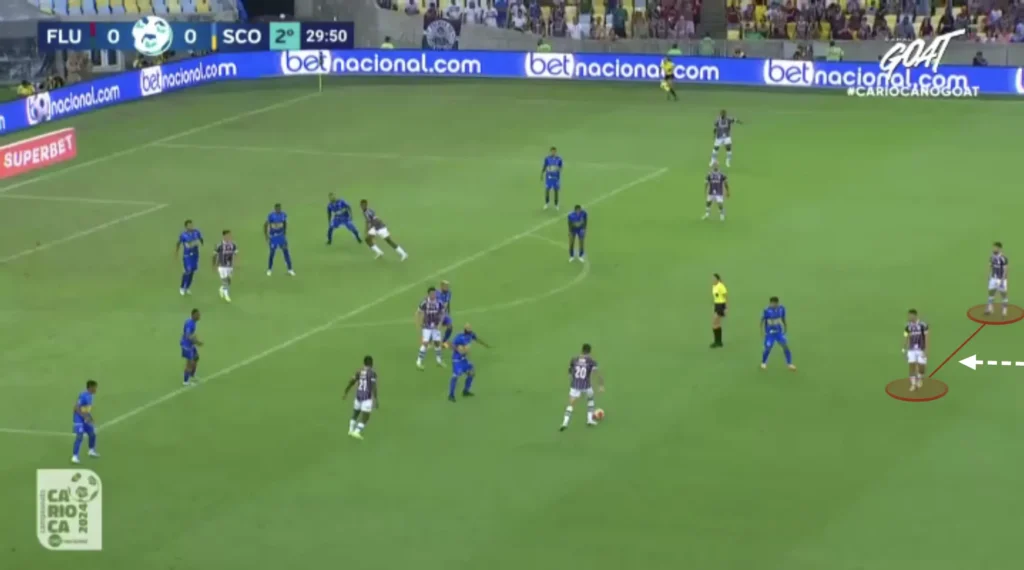
Final Third
Attacking the Half-Space
Fluminense is an excellent team in the final third. They create many chances, mainly by attacking the space between the opposition center-back and fullback. They primarily do this from the wide areas with underlaps from midfielders.
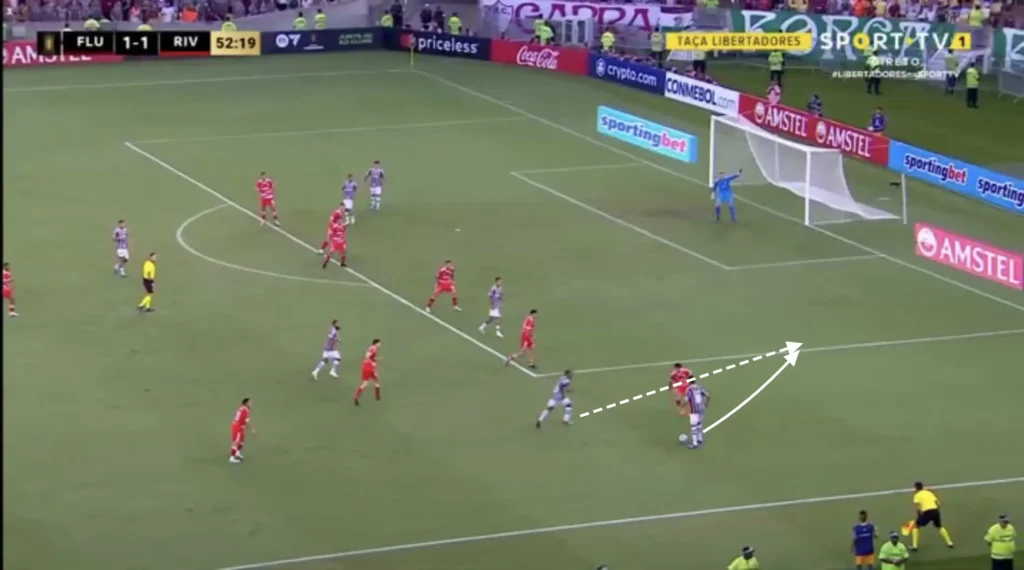
Overlaps
Fluminense also uses the overlap to produce opportunities in the final third. When the winger gets the ball, a Fluminense player quickly makes the overlap, creating a 2v1 on the wing. If the opposition fullback drops to cover the overlapping run, the winger could cut inside, taking a shot or combining with a midfielder. If the fullback covers the center, the ball can easily be played to the overlapping player, creating a crossing opportunity.

Many Players in the Box
Many Fluminense players look to make runs into the box when the ball is in the final third, often getting four or five players into these areas to create overloads. The numerical advantages in the box force the defending team to make decisions and leave some players open.
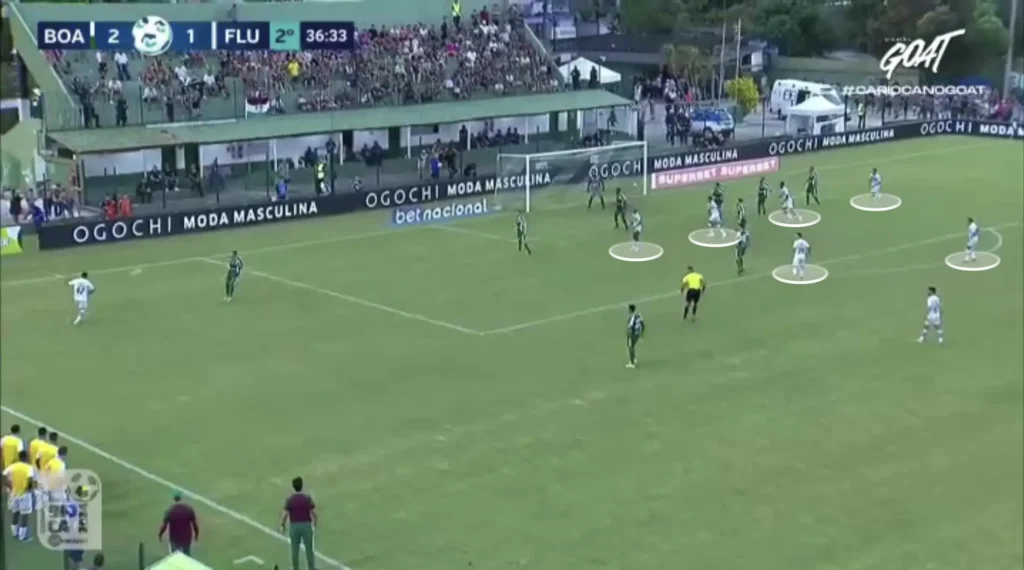
Fernando Diniz also wants many Fluminense players outside the box, ready for the second balls and cut-backs. They always succeed in pushing down the opposition’s defense, which opens the space in front of the backline. Fluminense often finds midfielders in these spaces who can shoot or combine with an attacker to create goalscoring opportunities.
Back Post
Fluminense’s striker is always positioned on the blindside of the weak-side center-back.

Staying on the blindside of defenders makes it difficult for them to know exactly where you are while you know exactly where they are. The Fluminense attackers, therefore, often run at the back post in crossing situations to be on the blindside and have complete control of their defender. The back post is where the space is, and the center-back’s lack of vision often makes it uncontested. In addition, the player defending that area is usually the fullback, who presumably will be a weaker aerial defender than the center-backs. German Cano is the master of the back post, scoring most of his goals from there.

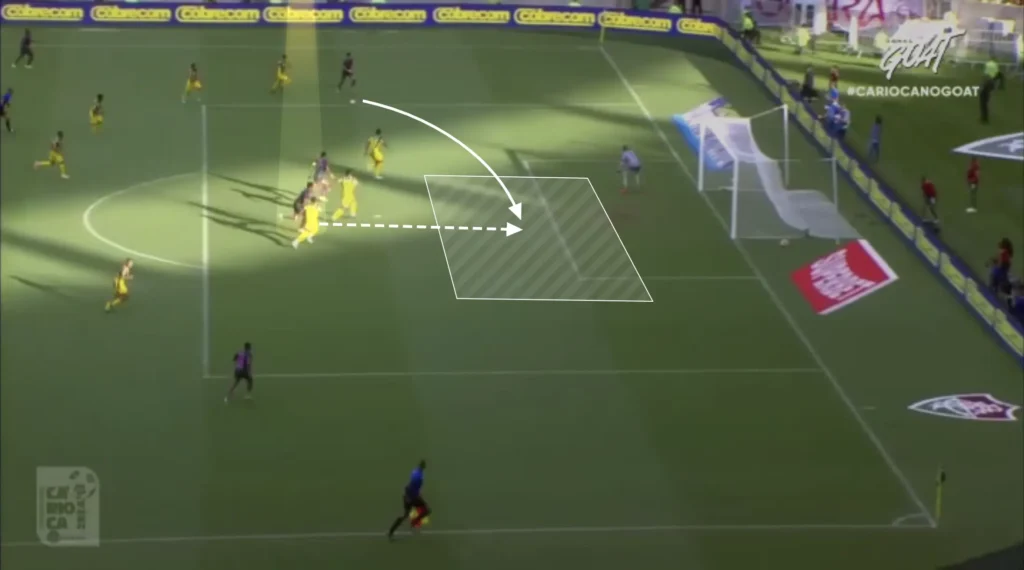
Principles and Tools
Keeping Possession
Under Fernando Diniz’s guidance, Fluminense epitomizes a possession-oriented style of play that emphasizes control and fluidity on the ball. Diniz instills a philosophy deeply rooted in ball retention, encouraging players to circulate possession patiently while probing for openings in the opposition’s defense. The team showcases intricate passing sequences, often building from the back with composure and precision. Players are instructed to seek numerical superiorities, utilizing short, quick passes to maintain possession and dictate the game’s tempo.
Third-man
Fernando Diniz, as established, wants his team to play through the opposition when possible. One vital tool that they often use is the third-man principle. This means using a third player to reach a free player whose passing lane is blocked.

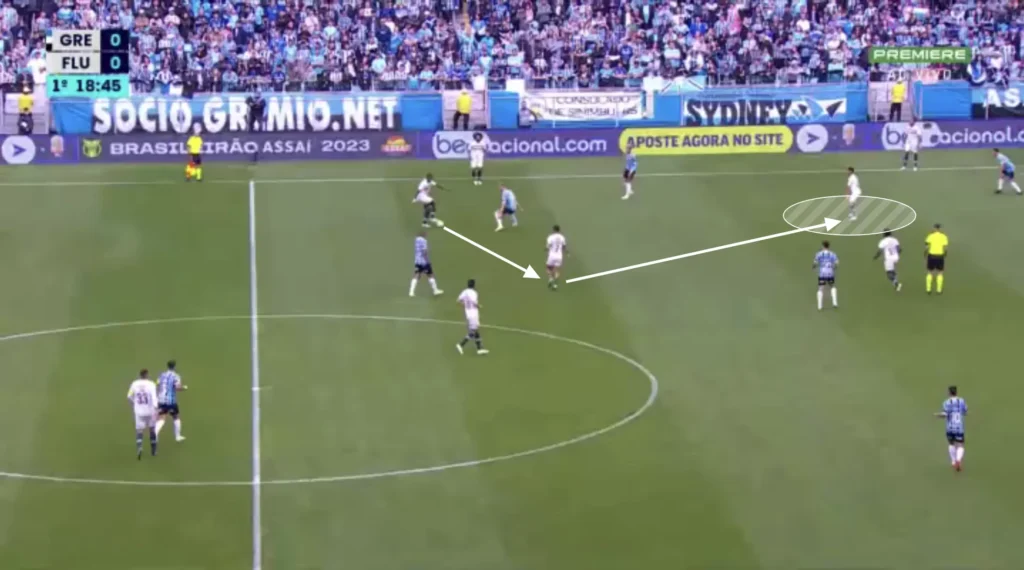
Bounce-pass
They also use bounce-passes to attract the opposition and open up their defense. A bounce-pass means passing the ball back and forth to make the opposition players push up and press. Here, an opposition midfielder is blocking the pass inside to the striker. The Fluminense players use a bounce-pass to draw out this defender and open the passing lane to the striker.

Give and Go
One influential principle of Diniz’s Fluminense is always moving after passing the ball. This is a massive part of Fluminense’s fluidity, creating new positions and passing opportunities every second. Here, a fullback plays the ball and makes a run inside. He does not receive the ball at first but continues the run, which allows him to receive the ball in a later situation.
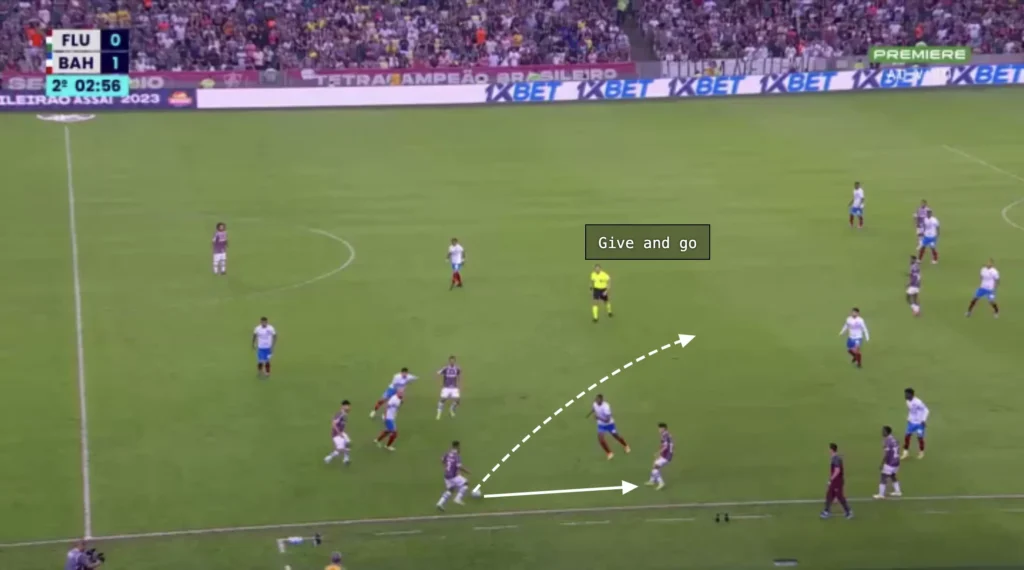
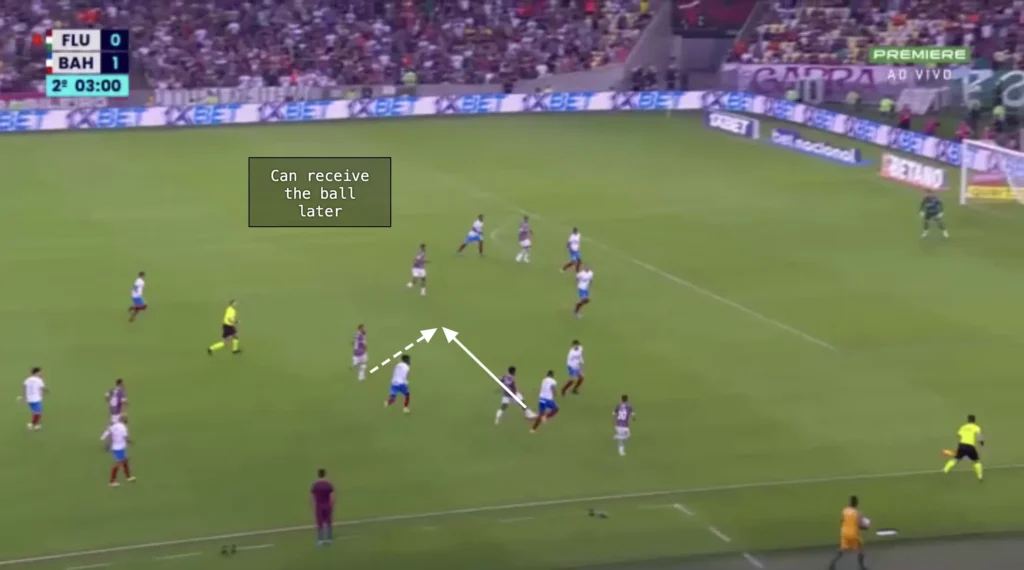
One-Two
An extension of Fluminense’s constant movement is one-two:s. The players always move after passing the ball, giving the player who received the ball the option to give it back in a new space. The one-two is extremely hard to defend and has become a vital tool in Fluminense’s build-up.
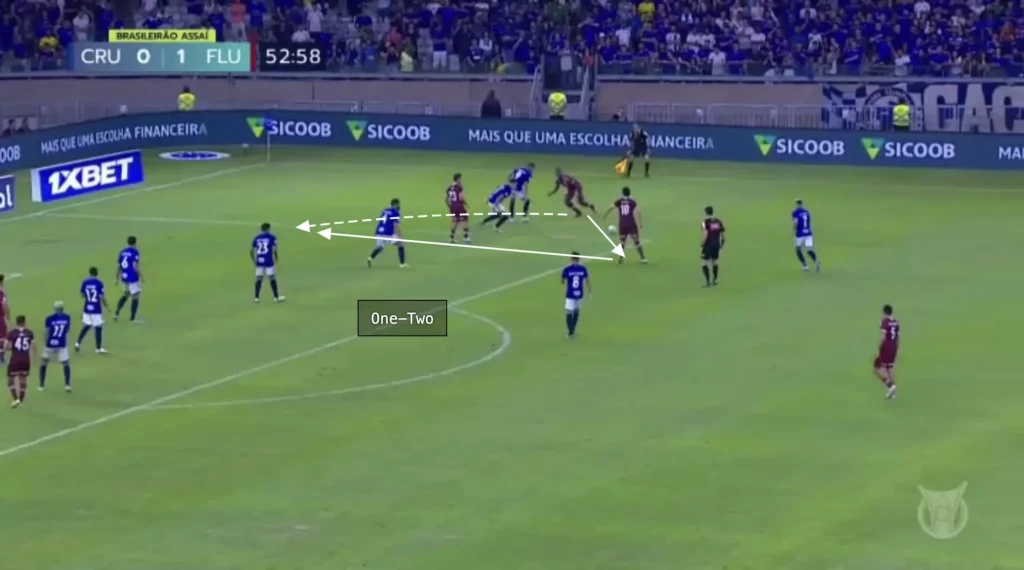

Diagonal Lines (Escandinha)
Fluminense also look to create diagonal lines, escandinha, between the players during their build-up. They are often seen in lines of three or four players working together to beat the opposition’s defense. Here, the “middle player” in the line opens the passing lane to the furthest player by making a run in behind.
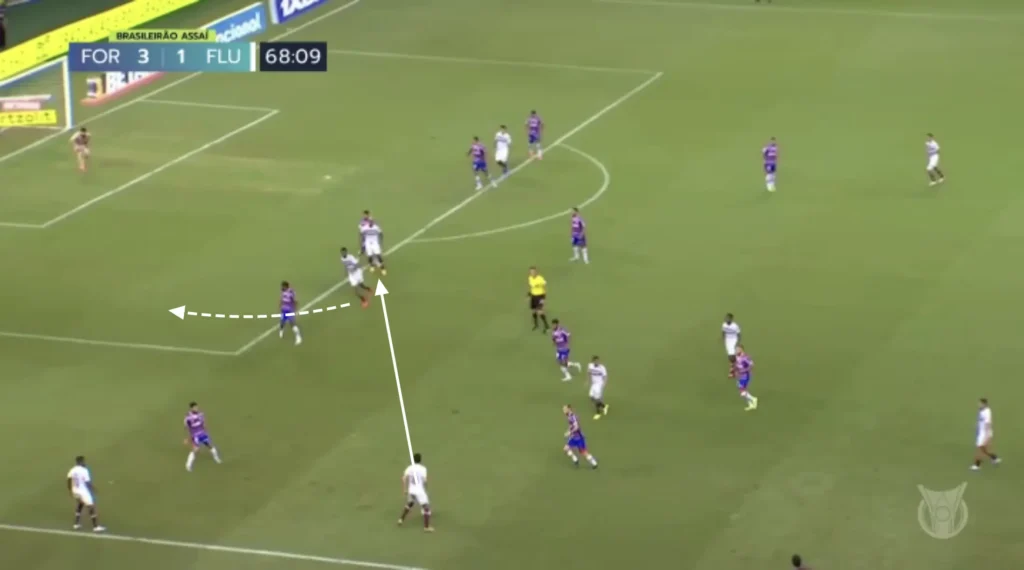
They also exploit these lines by jumping over the ball, confusing the opponents into not knowing who is receiving it.
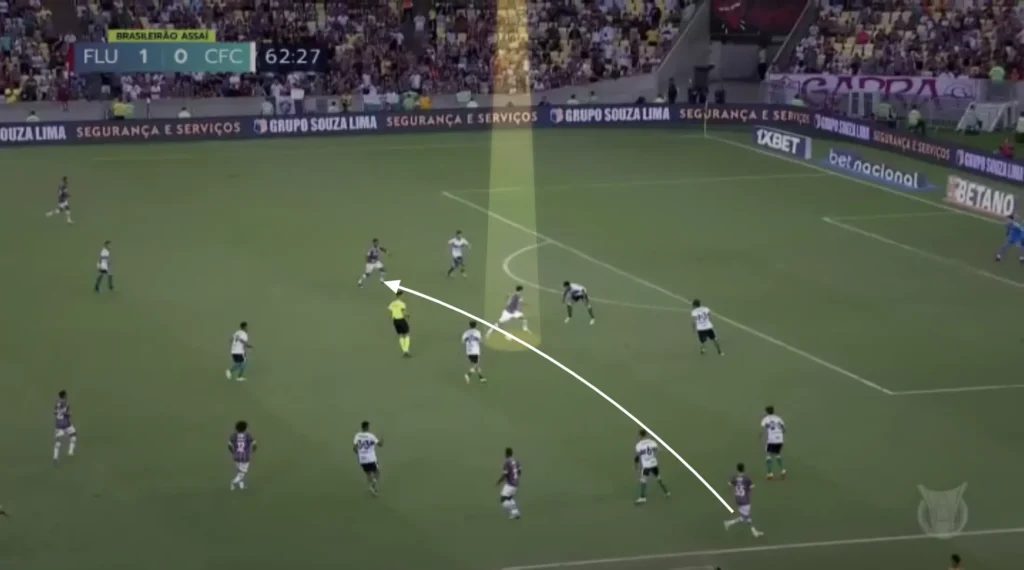
Defending
High Press
Fernando Diniz places much value in being aggressive without the ball. This shows in Fluminense’s high pressure. Diniz usually wants his team to go man-to-man and intensely press the opposition. They almost use their high press as an attacking threat, scoring many goals from winning the ball in their high press.
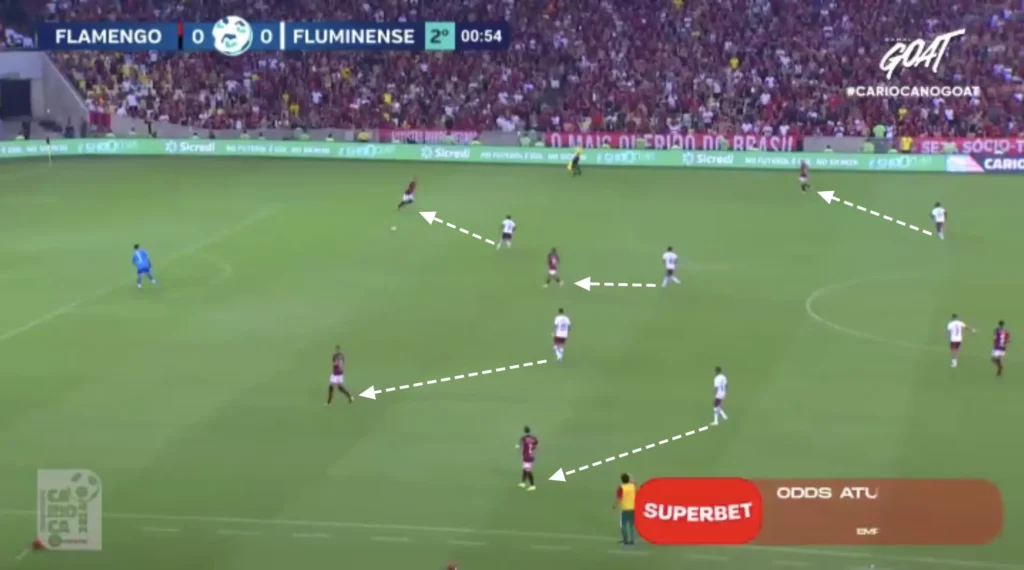
Low Press
In the low press, Diniz’s Fluminense uses a 1-4-4-2 formation. They look to set up in a mid-block, always trying to close the center, forcing the opposition out wide.
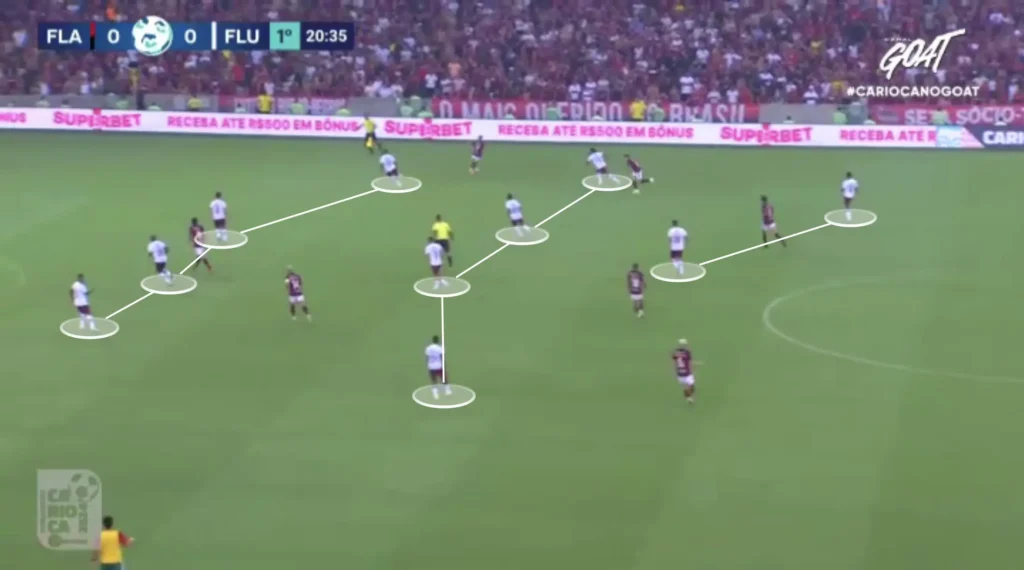
Fluminense looks to squeeze the pitch when defending. This means constantly pushing the team up as much as possible. Every time the opponent plays a slow, sideways pass or a back pass, Fluminense’s first line of pressure pushes up, with the rest of the team following to stay compact. When the next pass comes, they push up even more, forcing the opponent back even more. They do this because it pushes the opponent further away from Fluminense’s goal, making it harder to create chances.
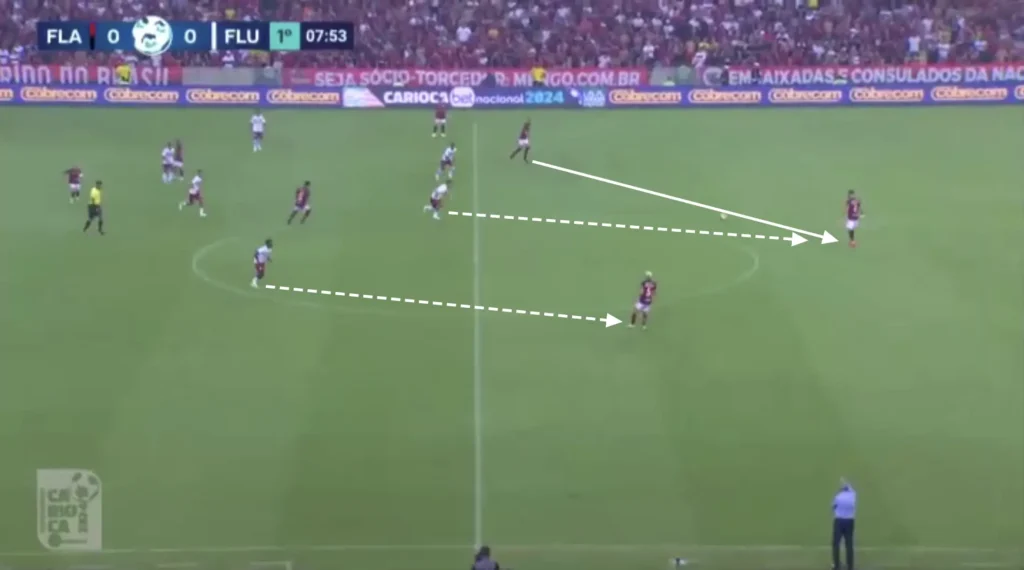
Defensive Transitions
Positioning many players on one side and creating numerical advantages creates good conditions in defensive transitions. Many players close to the ball after losing possession means that many players can work towards regaining possession. Focusing the play on the side also allows Fluminense to use the sideline as an extra defender. When they lose the ball, they can push the opposition towards the sideline and win the ball or stop a counterattack by getting it out for a throw-in. Therefore, Fluminense often successfully regains possession directly after losing it by counter-pressing the opposition.

Final Thoughts
In conclusion, our tactical analysis of Fernando Diniz’s tenure at Fluminense unveils a captivating blend of innovation and strategic nuances. Diniz’s commitment to expansive, possession-based football has redefined Fluminense’s identity while leaving an indelible mark on the football world. Throughout our examination, we’ve witnessed the meticulous attention to detail in Diniz’s tactical setup, emphasizing fluidity, movement, and quick transitions. His ability to instill a coherent tactical framework has enabled Fluminense to compete at the highest levels, challenging traditional norms and captivating fans with their attractive style of play. As Diniz continues to evolve and refine his tactical approach, the future looks promising for Fluminense under his stewardship.
